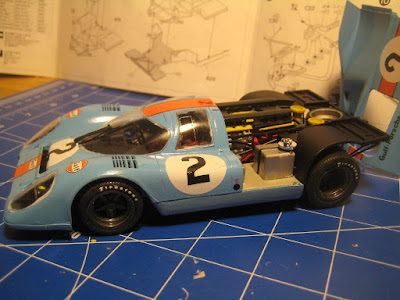The Fujimi rendition of forward chassis bits is quite detailed and shows a structure very much akin to the 908/03 chassis, perhaps not surprising given that both cars were run in 1970, the 908/03 on twisty circuits like Nurburgring or the Targa Florio, the 917 on faster circuits like Le Mans or Daytona. The cockpit is clearly scary, though, with the driver's feet well forward of the front axle centreline.

I washed the Historic Racing Miniatures bits in alcohol but this did not seem to result in any major amounts of mold release agents floating in the washing up, so I assume this level of cleanliness is part of the service when you pay for one of their kits. The resin is of good quality and flash is minimal, and the only issue is that some of the larger flat bits, like the bulkhead, are a bit warped. One of these days I'll get around to their Cheetah...
The HRM instruction sheet is pretty high-level and having reference material, either in the form of pictures from the web or, as in my case, access to the instruction sheet for the Model Factory Hiro kit, is useful if not critical. The distributors come predrilled as do the heads: there is nothing like a nicely wired ignition system. The injection pump is also predrilled but I will skip this due to lack of space and the relatively large diameter of the wiring available to me.
Here the left side is complete, with wires running through the injector stacks between the fan shroud and injection pump. Twin-plug heads were something of a fad at the time; I suspect that better ignition systems, combined with a realization that 4 valves per cylinder breathes better than 2 and only leaves room for one plug, was a large part of the end of this. The right side distributor wiring is a lot simpler given it doesn't have to snake around the fuel injection pump.

The completed engine looks good, although as always photos taken this close up show flaws that won't be visible once the engine is in the car. The main point is that the plug wires, from Model Car Garage, are a bit thick at 0.021" (over half an inch at scale).


The photos below contrast this 4.5 litre flat 12 with the 3 litre flat 8 from the 908/03. The earlier 2.2 litre version of the flat 8, as in the 907 (
click here), has the fan mounted on top of the crankcase, as does the 4.5; the 3 litre has it driven off the nose of the crank as with all aircooled 911s and most other aircooled Porsche racers of similar vintage.

Fuel injection pump location and distributor drive locations also varied from car to car. Again the layout of the 3 litre is closest to that of early 911's, up to and including the 2.7's.

Another interesting point is the final drive which is located just behind the clutch in the 917 but at the end of the gearbox in the 908. Perhaps this is one way to maintain similar wheelbases with four extra cylinders?

One interesting point from a kit-building perspective is the relative weight of the wiring in the MFH kit, which, at about 0.016" diameter, is a reasonable 3/8" at scale. Finding suitable plug wiring remains an issue and will continue to be a problem as the 24 plugs in the 917 motor required almost one and a half packages of MFG-3002 wire.
The chassis tub, along with the body, has been resprayed in the lighter shade of blue, so I am going to let it all set for a few days to avoid leaving a fingerprint in the paint when I rest my fat thumb in the roof panel. The engine will get exhaust and suspension bits, then get set aside until the paint is done.
Incidentally finding Testor's spray paints is becoming more difficult, at least in my neck of the woods; when I do find some, I'll stock up on the 1208C because there are a few Gulf Oil cars in the pipeline. This will, unfortunately, require a trip to the 'burbs.


















































